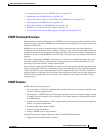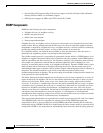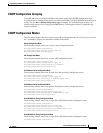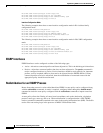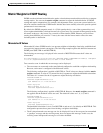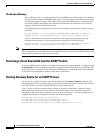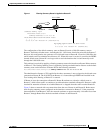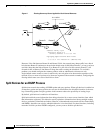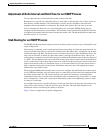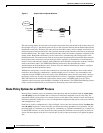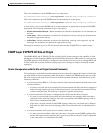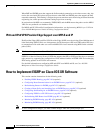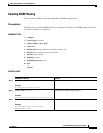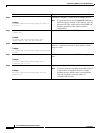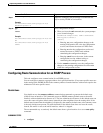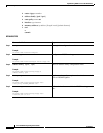
Implementing EIGRP on Cisco IOS XR Software
Information About Implementing EIGRP on Cisco IOS XR Software
RC-145
Cisco IOS XR Routing Configuration Guide
OL-14356-01
Adjustment of Hello Interval and Hold Time for an EIGRP Process
You can adjust the interval between hello packets and the hold time.
Routing devices periodically send hello packets to each other to dynamically learn of other routers on
their directly attached networks. This information is used to discover neighbors and learn when
neighbors become unreachable or inoperative. By default, hello packets are sent every 5 seconds.
You can configure the hold time on a specified interface for a particular EIGRP routing process
designated by the autonomous system number. The hold time is advertised in hello packets and indicates
to neighbors the length of time they should consider the sender valid. The default hold time is three times
the hello interval, or 15 seconds.
Stub Routing for an EIGRP Process
The EIGRP Stub Routing feature improves network stability, reduces resource usage, and simplifies stub
router configuration.
Stub routing is commonly used in a hub-and-spoke network topology. In a hub-and-spoke network, one
or more end (stub) networks are connected to a remote router (the spoke) that is connected to one or more
distribution routers (the hub). The remote router is adjacent only to one or more distribution routers. The
only route for IP traffic to follow into the remote router is through a distribution router. This type of
configuration is commonly used in WAN topologies in which the distribution router is directly connected
to a WAN. The distribution router can be connected to many more remote routers. Often, the distribution
router is connected to 100 or more remote routers. In a hub-and-spoke topology, the remote router must
forward all nonlocal traffic to a distribution router, so it becomes unnecessary for the remote router to
hold a complete routing table. Generally, the distribution router need not send anything more than a
default route to the remote router.
When using the EIGRP Stub Routing feature, you need to configure the distribution and remote routers
to use EIGRP and configure only the remote router as a stub. Only specified routes are propagated from
the remote (stub) router. The stub router responds to all queries for summaries, connected routes,
redistributed static routes, external routes, and internal routes with the message “inaccessible.” A router
that is configured as a stub sends a special peer information packet to all neighboring routers to report
its status as a stub router.
Any neighbor that receives a packet informing it of the stub status does not query the stub router for any
routes, and a router that has a stub peer does not query that peer. The stub router depends on the
distribution router to send the proper updates to all peers.
Figure 3 shows a simple hub-and-spoke configuration.



